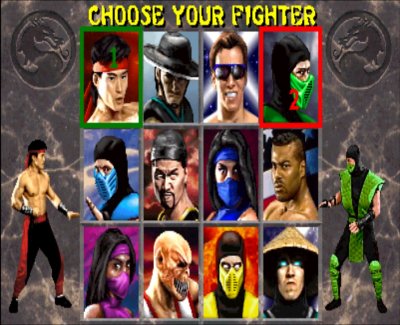
Maybe it’s because I grew up with Street Fighter and Mortal Kombat, but for me 12-16 has always seemed like the ideal roster size for a fighting game.
Review by Jay Wilson Eighteen years later, I’m playing Mortal Kombat 9 (2011) where, after 4 games in the realm of 3D, MK returns to a 2D plane ... and I find myself habitually entering MK2 combos. Off-hand, I don’t recall any finishing move inputs of MK3 or beyond, but ask me anytime anywhere about Mortal Kombat 2 and I can cite at least a half dozen Fatality inputs—I can even tell you how to shape shift into the character with Shang Tsung, and then do the Fatality. Mortal Kombat II reached an uncanny balance the series has never since managed to achieve which has given it the greatest replay value and allowed it to hold up so much better compared to its parent and children. One key lay in its simplicity. No dial-a-combos. No ‘run’ button. No 3D plane. No fancy cinematics. No extra modes of play. And no ridiculously excessive number of playable characters (not to mention palette swaps). MK2 was what it needed to be. Easy enough to pick up cold and get good while some devastating juggles required some serious practice to master ... but it didn’t require full-on dedication like some other fighting games out there. It offered a lot for its day, but it didn’t try to throw in four kitchen sinks along with the plumbing plus—what the hell?—an entire sewer system just for the sake of overkill like some of its later sequels did. No, Mortal Kombat 2 was simple. It featured five-buttons—high punch, low punch, block, high kick, and low kick. All characters shared the same basic moves including the uppercut (down+HP), the sweep (back+LK), and the roundhouse (back+HK). Observant players will notice subtle differences from character to character, but for the most part the major gameplay distinctions lay in the special moves and their ability to chain together for high damage combos. More competitive games tend to vary the speeds/ranges/power of the characters base moves a lot more than MK, and the more snobbish of the fighting game crowd often criticized MK for its uniformity. But the series has ventured away, making the characters more unique in all their attacks across the years (perhaps best accomplished in Deadly Alliance/Deception), but, truth be told, it really didn’t improve on anything (added something ‘different’, but not necessarily ‘better’.) 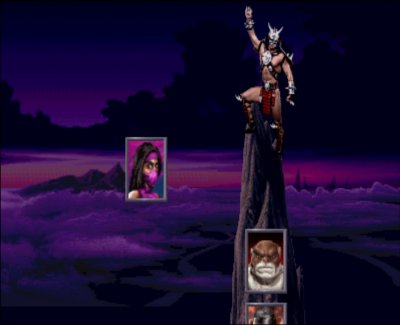
I always loved the mountain motif in MK2’s single player run with the boss, Shao Kahn, standing triumphantly on top.
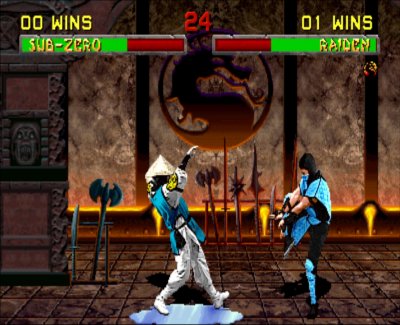
Sub-zero’s ground freeze, one of my favorite moves in the entire MK franchise, only appears here and in Ultimate MK3.

The hardest Fatality to pull off—not because the input was particularly complex (only one button)—rather, you had to keep LP held for 30 seconds which meant you handicapped yourself for the entire final round ... but it was worth it!
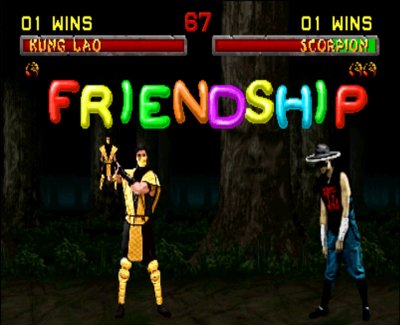
Go the winning round without using a punch, and you can perform one of the new finishing moves: a Friendship or a Babality.
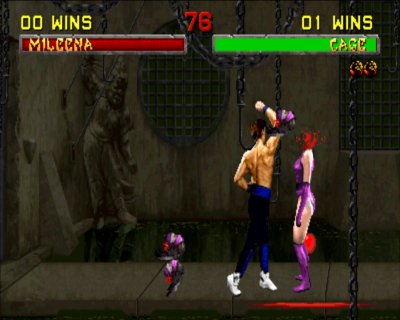
MK2 pays tribute to a glitch in the original Mortal Kombat which allowed Johnny Cage to perform his Fatality multiple times on the same victim.
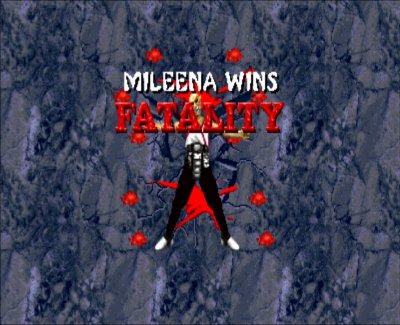
The new and improved Pit II not only requires a special Stage Fatality input, but it also shows a top-down perspective of its victim as they fall to their doom.
Another key lay in MK2’s balance of taking everything from the (let’s be honest) lackluster and underwhelming first game and going bigger. The original really was vastly overrated. I played the hell out of it at the time, don’t get me wrong, but looking back with the clarity of retrospect (and playing it again today), the first Mortal Kombat had tolerable mechanics and a gimmick—the controversial Fatalities. Thus, Mortal Kombat 2 could easily match every aspect of the original, and go light years beyond ... ... and it did. No other Mortal Kombat has so vastly improved upon its predecessor. Ever. The original game took place on a secluded island on Earth; the sequel takes us to Outworld, a whole other realm entirely. MK1 had seven playable characters; MK2 expands the roster to twelve including Reptile and Shang Tsung, the hidden character and the shape-shifting boss of the previous game. Mortal Kombat 1 had one secret character; Mortal Kombat 2 brings three hidden characters—Jade, Smoke, and Noob Saibot. MK1 had three palette swap characters (Scorpion, Sub-Zero, and Reptile); MK2 stretched the limit at eight (Scorpion, Sub-Zero, Reptile, Smoke, Noob Saibot, Kitana, Mileena, and Jade.) MK1 had seven stages; MK2 has ten. In MK1, the roundhouse kick made your opponent stagger back two steps; in MK2, the roundhouse knocks them flat on their back all the way across the screen. In MK1, Johnny Cage uppercut his opponents head off; in MK2, he does that and he has a second Fatality where he grabs them by the torso and rips them in half. But at the same time, Mortal Kombat 2 avoids going so far over the top it enters ‘stupid’ territory (such as MK3’s lame “Jax grows 50ft tall and steps on his opponent” Fatality.) Maybe it’s just me, but somehow it’s so much cooler when MK2’s Liu Kang turns into a dragon and bites his opponent in half (because dragons are cooler than giants.) Somehow the second Mortal Kombat walked the fine line of “fantastic yet means business” and not “accidental comedy ridiculous.” The first Mortal Kombat gave each combatant a single Fatality; MK2 delivers at least five Finishing options per character including two Fatalities (Shang Tsung has three); a Stage Fatality, which unlike the previous game, gives Fatality credit for knocking your opponent into the Armory ceiling or Pit II; the Friendships, an amusing joke Finisher in answer to protests of violent video games going on at that time; and the Babalities, a stupid Finisher that turns them into a baby which was included, if I may wager a guess, to squeeze one more finishing move into the game with minimal resources. Throw in one universal stage-specific Fatality for the Acid Pool, and that brings the grand total up to 62 (64 if you count Cage and Scorpion’s extended Fatalities ). More Fatalities, Bigger Fatalities, Badder Fatalities—like I said, Mortal Kombat 2 took everything from the first game and expanded it while (more or less) avoiding excess. In terms of raw game mechanics, the game feels faster, more dynamic, and less stilted. In the original game, if you jumped over your opponent you’d be facing the wrong way until you landed (ie, any aerial attack performed would automatically miss.) Starting with MK2, your character would adjust mid-jump which permitted you to land an attack which gave the fights some much needed flavor. Mortal Kombat 2 also added aerial moves into the mix, which allowed many characters to do more than just punch and kick when airborne. And, overall, the game flows more naturally from attack to attack, making the individual fights feel smoother and more refined. A third major factor in Mortal Kombat II’s supremacy lay in a series of little touches. Now blood drips from the word “Fatality” and the droplets splatter on the floor. When you knock your opponent into the ceiling spikes of the armory stage, if you immediately hold down on both joysticks their corpse will slide off the spikes and drop to the floor. When Reptile bites his opponent’s head off, he rubs his tummy, satisfied with his meal. As Shang Tsung, the input to morph into Sub-zero and Scorpion is their MK1 Fatality inputs. The hidden characters, Jade and Smoke, can be seen in the background of the Living Forest, peeking out from behind trees. Hidden characters are fought in Goro’s Lair from the first game. Some returning characters retain their original Fatality (Cage, Liu Kang, Scorpion). You can extend Cage’s uppercut decapitation Fatality in honor of a glitch from the first game. Kano and Sonya, the two original characters who did not return, can be seen chained up in the background of Kahn’s Arena. As the match starts and the “Round One” text appears, the lifebars fill up where most (if not all) previous fighting games showed them already full. The hidden game of Pong (dunno if it’s actually there—even I wasn’t a big enough MK2 fan to play 250 consecutive games to see it.) And, of course, the inexplicable “Toasty” guy (Sound & Music Designer Dan Forden) who pops up in the lower-right corner after a power move (usually an uppercut) which is the key to fighting Smoke. None of these really mean much on their own; however, their presence (and the sheer number of them) show an attention to detail the series has never seen before or since. When MK2 first hit arcades in ‘93, it seemed like every trip to the arcade uncovered another Finishing Move we hadn’t seen before, another reference to the first game, a new little easter egg ... it made you want to go back the next day and see what else you might find. Midway fighters were notorious for boss fights where the big baddies play by a different set of rules which doesn’t necessarily make them hard per se ... just stupid. For example, every attack has ‘recovery frames’ where the character is vulnerable. The idea is if you attack and fail to connect (miss or blocked), your opponent has a chance to hit you. However, if you attack and connect, the damage you cause will either cause a knockdown (like an uppercut or sweep) or cause a temporary stun (like MK1’s roundhouse kick) so they will not be able to do anything during your recovery frames. Or in other words, if you attack and hit you do the punishing. If you attack and screw up, they have a chance to punish you. Now, Goro (sub-boss of MK1) plays by a different set of rules. Try to sweep him. He will not be knocked down (as every other character is if sweeped) nor will he be stunned and, thus, he’s guaranteed free damage on you (and his attacks do way more damage.) Or, in other words, your reward for successfully setting up an attack and executing it perfectly? You get punished. 
If these two were hard, it was only because in MK1 you really couldn’t do a whole hell of a lot to begin with. Their natural and de-facto immunities limited your options even further resulting in a boring fight.
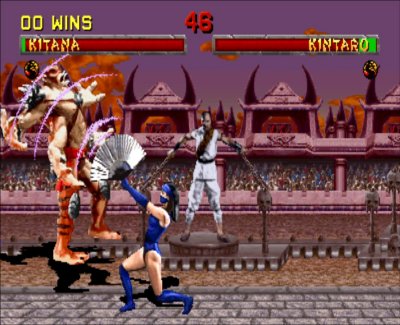
Not only was Kintaro cooler looking and badder than Goro could ever dream to be, but he (along with Shao Kahn) also represent the only time the series has had a fun boss fight.
Play stupid, get punished. Play smart, get punished. See how stupid this is? By the way, he’s also immune to throws. So, if you can successfully position yourself to throw him, you’ll at best get off a string of low punches which won’t amount to any worthwhile damage, and he will throw you. How do you like that? You can’t throw, but he can. To beat Goro, obviously you have to drop sweeps and throws from your game. However, the point of a fighting game is to beat your opponent. And a good, interesting, and deep fighter gives you options. The Midway fighting game bosses, including Mortal Kombat, play more like an action game boss (shoot here, and only here, to kill it.) It started with Goro, and evolved over the years and across the games so now in MK9 Shao Kahn cannot be thrown, takes half damage, deals double damage, has an unblockable stun projectiles, and can just auto-ignore your attacks. They don’t even feel like action/adventure game boss fights anymore. It feels like Midway (now NetherRealm Studios) is playing the role of ‘dad’ handing down handicaps so your toddler brother (who shouldn’t be playing the game at all) has a fighting chance. There comes a point where you’re blindfolded, with soundproof earplugs, working the controller with your feet as your hands are tied behind your back, and all you can do is ask, “why bother anymore?” Note to Ed Boon : your bosses aren’t tough. They’re spoiled rotten pampered little sissy brats. MK2 is the anomaly. Kintaro and Shao Kahn are both immune to throws, true, but there ends their special rules. You could sweep Kintaro and Shao Kahn, and if you successfully connected they would stagger back, and you’d be safe. They didn’t auto-void large chunks of your move set, so you had options dealing with them. Some options were better than others. Some were AI exploits that would rack up easy wins, and others were suicide because Kintaro or Kahn had a counter attack in their arsenal. But that was okay, because Kintaro and Kahn were actually doing something and earning their hits. It wasn’t like MK3’s centaur, Motaro, who inherently reflected all projectiles back at you just standing there doing nothing. With Kintaro, you didn’t want to throw projectiles because he had one too (which did more damage) ... but you could still try, and if you played your cards right, it would pay off. You were rewarded using your moves right. With MK3’s Motaro? “Yeah, that special ability we gave you? Now we arbitrarily decided you can’t use it. Period.” 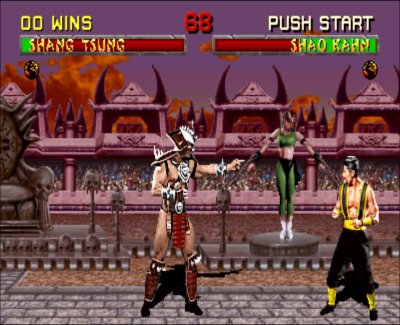
After Kintaro, Shao Kahn was actually pretty easy provided you weren’t trying to frame the image on a certain part of the stage, get him to taunt, and acquire a screen capture.
Kintaro and Shao Kahn did more damage, yes. They are bosses and should do more damage. But the damage ratios weren’t freakishly skewered like MK9 where you had to land, literally, seven-to-ten hits to match one of the boss’s. But, again, this really comes back to what makes a fighting game fun: options. In Mortal Kombat 2 against Shao Kahn and Kintaro, you could play reckless against them. You could take risks because while the chances still favored them, it could pay off for you. Mortal Kombat 9? The damage ratios are so severely tilted towards the boss that no risk is worth it. All options are off the table except the ones you know will work, and there’s literally only two strategies that will get you anywhere. Why give a character 50 attacks when only 3 will do anything? Mortal Kombat 2 may not be a perfect, but it towers above all other games bearing that dragon logo. MK2 rocked. | ||||||||||||||||||||
|
| ||||||||||||||||||||
